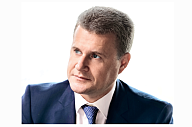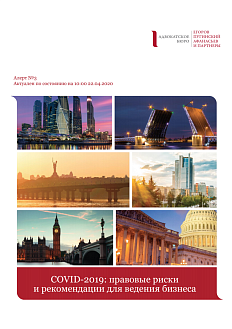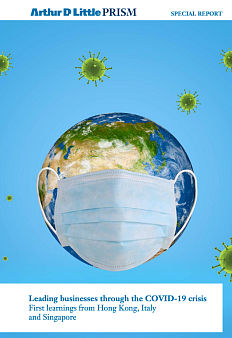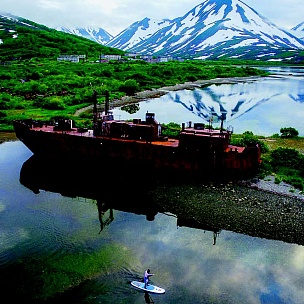Minister for the development of the Russian Far East and Arctic Alexei Chekunkov speaks about new opportunities offered by the far east in an evolving world, the impact of the pandemic, and an elite force of management personnel.
This years edition of the Eastern Economic Forum is taking place under the theme «The Opportunities for The Far East in a World under Transformation». What exactly are these new opportunities?
The last few years have seen enormous changes occur, with implications for all of humanity. There has been the pandemic, increasingly rapid technological progress, and paradigm shifts in energy and the environment. International relations are also evolving at speed. All this is changing the global landscape.
Firstly, there is energy. Fossil fuels and hydrocarbons are giving way to clean electric power. In terms of technology, knowledge, and capital invested in the industry, we have already reached critical mass. The exact time the world goes completely carbon- and hydrocarbon-free may still be a matter of debate, but the fact that the process is under way and the energy mix will change significantly over the coming decades is indisputable.

Secondly, there is the environment. The extreme climate phenomena witnessed around the world is a clear sign that the climate is changing. We could argue about the reasons for this as much as we like; however, in the words of Marx, «Practice is the criterion of truth». And practice has shown that nature is increasingly throwing up extreme surprises which are in turn taking an enormous toll on the economy and peoples lives. The environment and climate change are among the most pressing topics on the global agenda. At the same time, they are becoming big business as a new industry takes shape.
Thirdly, there is healthcare and the pharmaceutical industry. Just as the wars of the past accelerated technological progress, so the fight against the pandemic could result in a breakthrough in the biotech sphere and medicine. This would lead to improvements in healthcare, an increase in life expectancy, and to defeating serious illnesses.
Fourthly, remote working has become part of life throughout the globe. It was the first time in our history that this has happened life did not stop. Perhaps the world did not need as many offices as once thought and this is a multitrillion- dollar market. All these trends will shape how the world will evolve over the course of the 21st century.
So, moving on to the opportunities. The Far East is capable of producing vast quantities of clean energy. Today, only 23% of the regions hydropower resource potential is being utilized. The Far East boasts rivers, sunlight and wind in abundance, which are all potential sources of clean, renewable energy. The transition of entire economies to a hydrogen-based model is something which is being keenly discussed. This new economy of clean energy requires a huge amount of core resources. Indeed, the entire periodic table of elements will be needed to put modern systems in place, including electric motors and power storage units. Whereas in the past we focused on oil, gas, gold and coal, today we are finding a broad spectrum of materials to be of high added commercial value.
In terms of the environmental agenda, the Far East could become a major global centre of green commerce. After all, it is the largest green space in the world. There will be a pressing need for forest care technologies, along with efforts to increase the absorptive capacity of the forest industry. The Far East could become one of the worlds main producers of carbon credits.

With regards healthcare and the pharmaceutical industry, the Far East stands out in two aspects. Firstly, it offers the best legal and taxation framework for doing business. There are advanced special economic zones, the Free Port of Vladivostok, a special administrative regime on Russky Island, and the Russian Arctic. On top of this, the President of the Russian Federation recently announced a new highly attractive tax regime for the Kuril Islands, which is about to be put in place. Under these regimes, it is more profitable to establish new high-tech production operations than elsewhere. Given developments in robotization and energy affordability, the Far East is an attractive place to manufacturers, including pharmaceutical companies. Another niche is medical tourism we are able to offer high quality medical care and professional doctors. Demand for these services is enormous in the Asia-Pacific region, and the Far Easts proximity to this multi-billion-dollar market is giving rise to new strategic opportunities.
Given the new options in communication, training, and work, the Russian Pacific could become a new frontier a place of experimentation. This is one of the most environmentally pure and beautiful places on earth, and the region offers a wealth of opportunities to interact with nature and live a life that would have been considered rather unconventional in the 20th century when compared to regular city life. In order to ensure that we take full advantage of each of these trump cards, tireless and concerted efforts are needed from each one of us.
How has the pandemic affected the regions economy?
The economy of the Russian Far East weathered the pandemic. GRP declined by no more than 1.8% compared to figures for 2019 a third less than the Russian average. The SME sector and the services industry experienced issues, as they did in other regions across Russia. In order to shore up this important sector of the economy, a range of measures were put in place to support business owners. Large production sites did not shut down, however. Indeed, a number of new ambitious projects got under way during the pandemic. There is the Baimskaya Ore Zone in Chukotka, for example, or the Ozernoye Deposit in Buryatia. Similarly, the pandemic has not stopped work on a number of key transnational infrastructure projects. Notable examples include the construction of a highway bridge in Amur Region and a railway bridge in the Jewish Autonomous Region connecting Russia to China. And as traffic increases, so cooperation between our nations will reach a fundamentally new level.
Today, Primorye Territory is home to advanced special economic zones, the Free Port of Vladivostok, and a special administrative district. Why are so many initiatives of this kind needed?
Together, more than 2,600 investment projects are under way in 22 advanced special economic zones and the Free Port of Vladivostok. This regime is spread out across 22 municipalities in five regions. More than 500 residents are based in advanced special economic zones alone, and every week this figure is growing. These zones were established for mediumsized and large enterprises. Together, they make up the most popular and significant incentive regime in Russia, if one goes by the value of agreements signed and the amount of money invested. Indeed, residents of these zones have signed agreements worth a total of more than RUB 4.4 trillion, of which RUB 1.2 trillion has been invested. In addition, more than 40,000 jobs have been created. Thanks to the incentives and preferences in place, these zones are seeing complex and ambitious projects being implemented of the kind that havent been seen for decades. The development of the Udokan and Baimskoye deposits are just two such examples.

The Free Port of Vladivostok is a relatively new regime, which was put in place after the establishment of advanced special economic zones. Nevertheless, the broad selection of incentives on offer, together with reduced red tape, mean that it is popular with small and medium-sized enterprises. More than 2,000 residents are based there, and more than 260 enterprises are already fully operational. Agreements worth a total of RUB 1.1 trillion have been signed, and RUB 202 billion has already been invested. This has all translated into the creation of 25,000 new jobs.
The special administrative district on Russky Island was established to redistribute Russian capital from less friendly jurisdictions without shouldering a tax burden. This regime is only just getting off the ground. Work is currently under way on reviewing a range of ambitious pilot projects, several of which will be presented at the Eastern Economic Forum.

Another new form of government support is specifically focused on the Russian Arctic. How important is this initiative for businesses?
With an area of 5 million square kilometres, the economic zone in the Russian Arctic is the largest of its kind anywhere in the world. Although only established in 2020, it already has more than 160 residents. Investments in various projects total RUB 257 billion, and 8,000 jobs are being created in transport and logistics, mineral extraction and processing, tourism, fishing, manufacturing, and services. In addition, eight projects worth RUB 95 billion have been registered at the Capital of the Arctic advanced special economic zone.
The government is compensating infrastructure construction costs associated with major investment projects. Among those benefitting from this form of support are project developers operating in mineral extraction, port infrastructure, logistics, and aquaculture. Construction projects in Murmansk Region, for example, include a mining and metals plant, a specialized deep-sea mineral fertilizer transhipment terminal, and a salmon and trout hatchery. Work on developing the Syradasayskoye coal deposit is set to begin on the Taymyr Peninsula. A project to build a lead-zinc ore extraction and processing enterprise on the Novaya Zemlya archipelago (Yuzhny Island) is under way. In total, the government is set to support more than RUB 200 billion-worth of investment in new projects. These will not only create jobs and bring socioeconomic benefits to the Arctic, they will also lead to increased freight traffic along the Northern Sea Route.
Under the national development programme for the Far East, quality of life should improve at a faster rate than the Russian average across all parameters over the next four years. How will this be achieved, given that regional budgets are relatively modest?
There is no room for discussion here the objectives set by the President will be achieved. A major social development programme for centres of economic growth is currently being implemented in the Far East. Over the course of three years, more than RUB 100 billion has been invested in building and modernizing 1,500 social institutions, sites, and facilities. These include clinics, schools, nursery schools, and social infrastructure. The government has allocated substantial funds towards subsidizing flights and social benefits, and a package of measures aimed at improving quality of life for people in the Far East is being implemented. We are working to address the budget deformations that have taken root over many years. This is with a view to attracting additional resources to the region, and to ensuring that the programmes of all relevant government bodies include the necessary measures. At the same time, we are introducing new mechanisms for using public funds. The aim of these is to attract private investment for infrastructure, including social infrastructure. This will be achieved through concessions, which we plan to put in place for projects forming part of the Far East and Arctic Concession programme worth up to RUB 500 billion.

Among the events to take place at the Eastern Economic Forum will be a presentation of the Muravyov-Amursky 2030 programme to train managerial personnel for the Far East. Is there a sense that good managers are in short supply?
We are launching a far-reaching programme to not just train managerial personnel, but to create an elite force of managerial talent for development in the Far East and Arctic. Its a special kind of work which carries with it special requirements not only in terms of education and motivation, but also in terms of physical capacity and resilience to stress. Its important to be prepared to constantly be on the move between time zones. The objective is to recruit leaders who are not only keen on testing their skills in the civil service, but who are also ready to tackle complex and ambitious challenges. The programme involves a tough selection process from the off to be accepted, candidates need to pass a series of difficult and rigorous tests. Some of the best higher education institutions in the country have joined the initiative as partners. These include the Graduate School of Public Management, Skolkovo, the Russian Academy of Public Administration, Moscow State University, and the Higher School of Economics. As well as receiving training, these elite forces will work in direct contact with those responsible for the development of the Far East from the minister, to city mayors. As a result, they will have the chance to fully immerse themselves in the Far East context. Those who complete the two-year course will possess a unique set of skills and knowledge which will be vital for the development of our nations geostrategic regions.






